
The first USS Philip (DD–76) was a Wickes-class destroyer in the United States Navy during World War I, later transferred to the Royal Navy as HMS Lancaster. She was named for John Woodward Philip.

USS Breckinridge (DD–148) was a Wickes-class destroyer in the United States Navy during World War II, later reclassified as AG-112. She was named for Ensign Joseph Breckinridge.
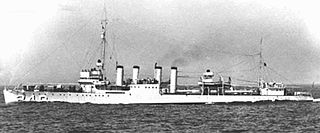
USS Sturtevant (DD-240) was a Clemson-class destroyer in the United States Navy during World War II. She was the first ship named for Albert D. Sturtevant.

The third USS Bainbridge (DD-246) was a Clemson-class destroyer in the United States Navy during World War II. She was named for Commodore William Bainbridge, who served in the War of 1812 and the First and Second Barbary Wars.
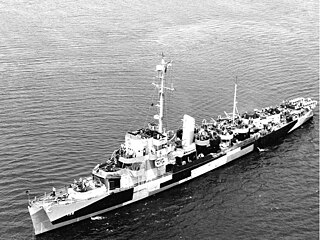
USS Peterson (DE–152) was an Edsall class destroyer escort, the first United States Navy ship so named. This ship was named for Chief Water Tender Oscar V. Peterson (1899–1942), who was awarded the Medal of Honor posthumously for his actions during the Battle of the Coral Sea.
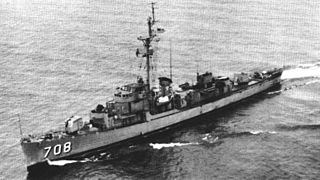
USS Parle (DE-708), a Rudderow-class destroyer escort of the United States Navy, was laid down on 8 January 1944 at the Defoe Shipbuilding Company, in Bay City, Michigan. She was launched on 25 March 1944, sponsored by Mrs. Harry V. Parle, mother of Medal of Honor recipient Ensign John Joseph Parle, and commissioned in New Orleans on 29 July 1944.

USS Thaddeus Parker (DE-369) was a John C. Butler-class destroyer escort in service with the United States Navy from 1944 to 1946 and from 1951 to 1967. She was scrapped in 1968.

USS Amick (DE-168) was a Cannon-class destroyer escort built for the United States Navy during World War II. She served in the Atlantic Ocean and then the Pacific Ocean and provided escort service against submarine and air attack for Navy vessels and convoys.

USS Blair (DE-147) was an Edsall-class destroyer escort in service with the United States Navy from 1943 to 1946 and from 1951 to 1960. She was scrapped in 1974. Blair was named in honor of Chief Machinist's Mate Eugene Blair, who was awarded the Silver Star posthumously for his brave actions when his ship was attacked and bombed by Japanese planes near Port Darwin, Australia, in mid-February 1942.

USS Otterstetter (DE-244) was an Edsall-class destroyer escort built for the U.S. Navy during World War II. She served in the Atlantic Ocean the Pacific Ocean and provided destroyer escort protection against submarine and air attack for Navy vessels and convoys.

USS Snowden (DE-246) was an Edsall-class destroyer escort built for the U.S. Navy during World War II. She served in the Atlantic Ocean the Pacific Ocean and provided destroyer escort protection against submarine and air attack for Navy vessels and convoys.

USS Howard D. Crow (DE-252) was an Edsall-class destroyer escort built for the U.S. Navy during World War II. She served in the Atlantic Ocean the Pacific Ocean and provided destroyer escort protection against submarine and air attack for Navy vessels and convoys.
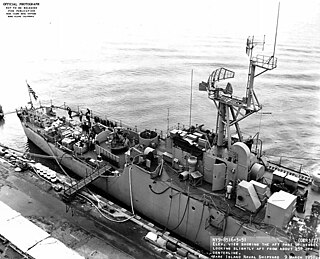
USS Joyce (DE-317) was originally commissioned as a US Coast Guard Edsall-class destroyer escort built for the U.S. Navy during World War II. She served in the Atlantic Ocean and the Pacific Ocean and provided destroyer escort protection against submarine and air attack for Navy vessels and convoys. During its World War II service, on two different engagements with enemy submarines, the Joyce rescued survivors of the tanker SS Pan- Pennsylvania and its sister ship USS Leopold. Joyce received one battle star for its service during World War II.

USS Raymond (DE-341) was a John C. Butler-class destroyer escort acquired by the U.S. Navy during World War II. The purpose of the destroyer escort was primarily to escort and protect ships in convoy, in addition to other tasks as assigned, such as patrol or radar picket. Post-war, she returned home with five battle stars to her credit, including credit for her striking a Japanese cruiser with her 5-inch (127 mm) guns during the Battle off Samar. The destroyer escort was named for Reginald Marbury Raymond, who was killed by enemy gunfire on 30 April 1943 aboard USS Scorpion.

USS Maurice J. Manuel (DE-351) was a John C. Butler-class destroyer escort acquired by the U.S. Navy during World War II. The primary purpose of the destroyer escort was to escort and protect ships in convoy, in addition to other tasks as assigned, such as patrol or radar picket.

USS Woodson (DE-359) was a John C. Butler-class destroyer escort acquired by the United States Navy during World War II. The primary purpose of the destroyer escort was to escort and protect ships in convoy, in addition to other tasks as assigned, such as patrol or radar picket.

USS Melvin R. Nawman (DE-416) was a John C. Butler-class destroyer escort in service with the United States Navy from 1944 to 1946. She was recommissioned from 1951 to 1960 and finally sold for scrap in 1973.

USS Chester T. O’Brien (DE-421) was a John C. Butler-class destroyer escort in service with the United States Navy from 1944 to 1946 and from 1951 to 1960. She was scrapped in 1974.
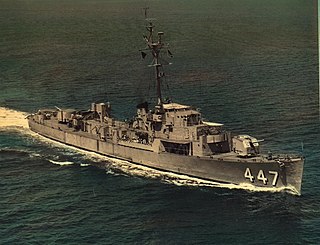
USS Albert T. Harris (DE-447) was a John C. Butler-class destroyer escort acquired by the U.S. Navy during World War II. The primary purpose of the destroyer escort was to escort and protect ships in convoy, in addition to other tasks as assigned, such as patrol or radar picket. Post-war she returned home with two battle stars to her credit.

USS Hollis (DE-794/APD-86) was a Buckley-class destroyer escort in service with the United States Navy from 1944 to 1947 and from 1951 to 1956. She was scrapped in 1975.




















